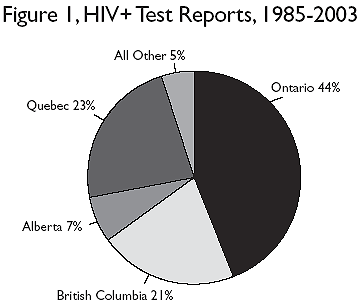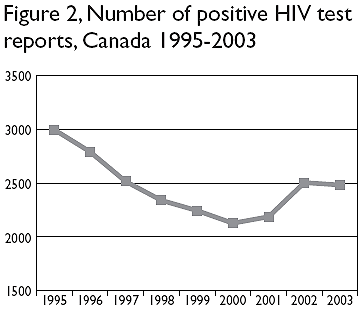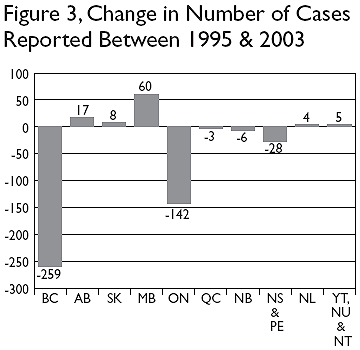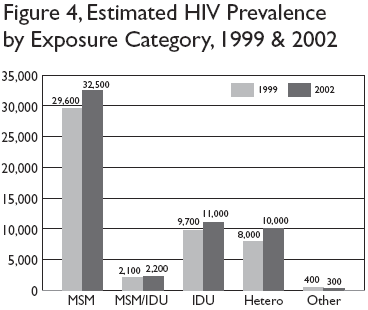Common menu bar links
Institutional links
Diseases & Conditions
Health & Safety
Research & Statistics
Agency Information
Search Box
A Report on Governments' Responses to the HIV/AIDS Epidemic in Canada
A National Portrait
Previous | Table of Contents | Next
2. An Overview of HIV/AIDS Surveillance Data
The data presented below provide a context for the federal, provincial and territorial policy responses described in Section 3 and analyzed in Section 4. Those responses, for example, may be influenced by the number of new diagnoses in each jurisdiction, by incidence trends, by the total number of people living with HIV/AIDS and by the changing character of the epidemic.
According to Health Canada estimates, approximately 56,000 people in Canada were living with HIV infection (including AIDS) at the end of 2002, a 12.5% increase since 1999. Figure 14 shows data for cumulative HIV positive test reports from 1985 to 2003 and illustrates that the epidemic has been concentrated in four jurisdictions, with British Columbia, Alberta, Ontario and Quebec having 95% of all HIV positive test reports while having only 85% of the Canadian population. Nevertheless, as presented in Table 1, every jurisdiction has reported some cases.5

| Jurisdiction | Total |
|---|---|
| British Columbia | 11,552 |
| Alberta | 3,961 |
| Saskatchewan | 460 |
| Manitoba | 1,097 |
| Ontario | 24,408 |
| Quebec | 12,464 |
| New Brunswick | 313 |
| Nova Scotia & PEI | 626 |
| Nfld. & Labrador | 221 |
| Yukon, Nunavut and the Northwest Territories | 78 |
| Total | 55,180 |
From 1985 to 1994, there were almost 33,000 positive HIV test reports (all ages), an average of 3,300/year. Figure 2 shows that the annual number of such reports declined steadily to 2000 and then increased in both 2001 and 2002 before remaining essentially unchanged in 2003.6

Figure 3 compares 1995 and 2003 and presents the change in the number of HIV positive reports by jurisdiction.7 Five of the ten jurisdictions reported more new reports in 2003 than in 1995. Canada as a whole reported 514 fewer reports in 2003 than in 1995.

Figure 4 presents estimated HIV prevalence by exposure category for both 1999 and 2002.8 The largest absolute increase (2,900 cases) during this time was in the men who have sex with men (MSM) exposure category while the largest relative increases were in the heterosexual (25%) and injection drug use (IDU) (13%) categories. In terms of incidence, MSM represented 40% of new HIV infections in 2002 while IDU represented 30% and the diverse heterosexual exposure category 24%.9

At the end of 2002, there were an estimated 7,700 women in Canada living with HIV/AIDS representing 14% of the national total and an increase of 13% from 1999. Women represented 23% of new infections in Canada, a similar finding to 1999. HIV positive test reports (new diagnoses) among women have increased from 8.9% between 1985 and 1992 to 25.3% in 2003.10
The epidemic continues to be acute among Aboriginal people. While constituting approximately 3.3% of the Canadian population, Aboriginal people represented 13.4% of all AIDS diagnoses and 25.3% of all positive HIV test reports in those provinces that submitted ethnicity data in 2003.11 Where data were available on ethnicity, approximately 63% of HIV positive reports among Aboriginal peoples were attributed to injection drug use compared to 30% among other Canadians.12 People from countries in which HIV is endemic are also over-represented among those with HIV/AIDS in Canada. They represent 1.5% of the country's total population but 7%-10% of estimated prevalent cases and 6%-12% of estimated new infections.13
Although the number of young people (10-24 years) living with HIV/AIDS in Canada is small, their potential for spreading the virus is significant due to a variety of factors. Furthermore there have been 224 paediatric (children 0-14 years) AIDS cases in Canada of which 175 (78%) were attributed to perinatal transmission. Studies undertaken in Quebec, British Columbia, Alberta and elsewhere in the world, meanwhile, all show the effectiveness of treatments currently available to prevent perinatal transmission. 14
Perhaps 30% of those living with HIV/AIDS in Canada today - approximately 17,000 people - are not aware of their condition and consequently are not accessing treatment and may unknowingly be transmitting the virus to others.
4 Canada, Health Canada, 2004(a).
5 Data for both Figure 1 and Table 1 are drawn from Canada, Health Canada, 2004:23. Data from Saskatchewan are preliminary only.
6 Canada, Health Canada, 2004:11.
7 The jurisdictional tables in Section 3 (below) provide the data for this Figure.
8 Canada, Health Canada, 2003(a):200.
9 Canada, Health Canada, 2004:24.
10 Canada, Health Canada, 2004:24,13.
11 Canada, Health Canada, 2004:25.
12 Canada, Health Canada, 2004 (a):48.
13 Canada, Health Canada, 2003(a):203-04.
